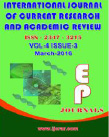Abstract Volume:4 Issue-3 Year-2016 Original Research Articles
 |
Online ISSN : 2347 - 3215 Issues : 12 per year Publisher : Excellent Publishers Email : editorijcret@gmail.com |
Breeding and Life Cycle of Fresh Water Ornamnetal Shrimp-Indian White Banded Shrimp, Caridina cf. babaulti Var. Indian White Banded
Jehovah Shamma Centre for Marine and Wildlife Research, Mudiveeranpattinam, Ramanathapuram Dt-623513, Tamil Nadu, India
*Corresponding author
Abstract:
There is an evergreen demand for ornamental shrimps in the scope of planted aquarium or in dedicated aquaria this exponential growth in the demand needs a steady supply of stocks so the main objective of this research is to develop a standard hatchery technology for fresh water ornamental shrimps. An endemic species Indian White banded Shrimp, Caridina cf. babaulti was selected, as the documented information about the species is scare. Thus, this study was conducted to gather some information on its breeding behavior and life cycle until first maturity in laboratory condition.10 pairs of Indian White banded Shrimp, Caridina cf. babaulti are kept in confined system separately. The tanks are populated with common aquatic plants (Java fern Microsorum pteropus, Amazon sword Echinodorus bleherae, Anubias nana, Cryptocoryne sp., Rotala indica and mosses (java moss Taxiphyllum barbieri, Christmas moss Vesicularia montagnei) and regulated with periodic photoperiods and Co2 supply. With carefully monitored water quality parameters, the selected species was bred in confined system. It was observed that water temperature is one of the parameter that played a crucial role in influencing the spawning behavior of the species. Larvae assume a benthic lifestyle after hatching, i.e. they are miniature versions of the adults. There is no planktonic larval stage. The hatchlings of this shrimp are extremely small and grow slowly.
Keywords: Caridina cf.babaulti,Life cycle of fresh water, Ornamnetal shrimp,Slime production, DNAse and Haemagglutination.
Download this article as How to cite this article:
Ganesh Ariyanathan and J. Sesh Serebiah. 2016. Breeding and Life Cycle of Fresh Water Ornamnetal Shrimp-Indian White Banded Shrimp, Caridina cf. babaulti Var. Indian White Banded.Int.J.Curr.Res.Aca.Rev. 4(3): 48-55doi: http://dx.doi.org/10.20546/ijcrar.2016.403.006
Copyright: This is an Open Access article distributed under the terms of the Creative Commons Attribution-NonCommercial-ShareAlike license.



Quick Navigation
- Print Article
- Full Text PDF
- How to Cite this Article
- on Google
- on Google Scholor
- Citation Alert By Google Scholar
